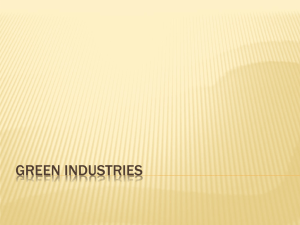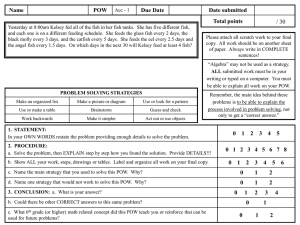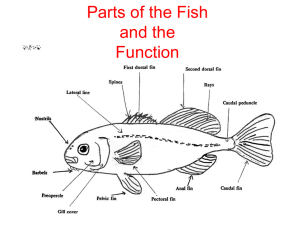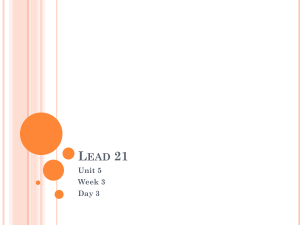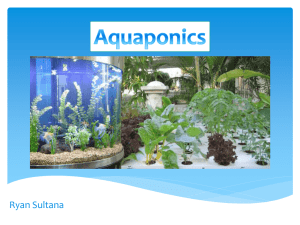Document
advertisement
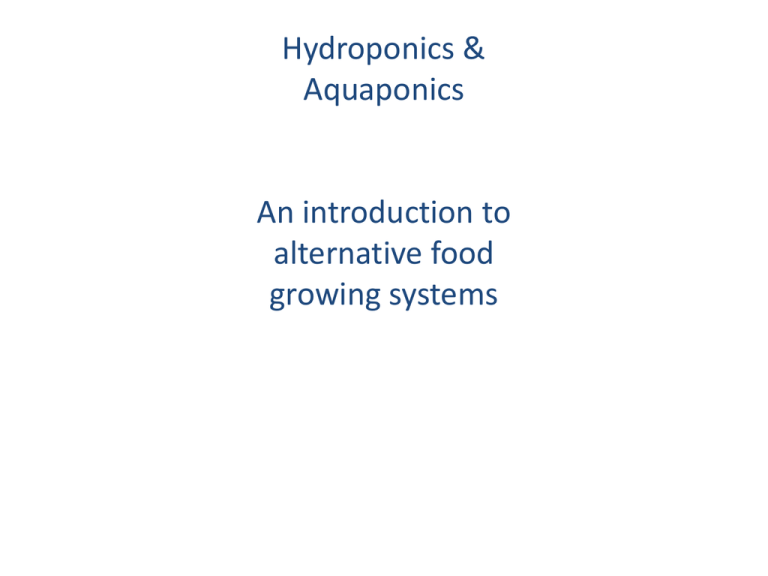
Hydroponics & Aquaponics An introduction to alternative food growing systems Hydroponics What is hydroponics? • Growing plants in water, without soil • • • • • • Efficient Fast growing Crop density is high/limited space Less pests, weeds, and soil borne diseases Less physical labor Less water than traditional farming Hydroponics isn’t new • 1627 book Sylva Sylvarum by Francis Bacon • In 1699, John Woodward published his water culture experiments with spearmint • In 1937 William Frederick Gericke of the University of California at Berkeley first coined the term hydroponics NASA Hydroponics How does it work? • Plants are suspended in a ph neutral medium • Nutrient rich water is pumped through allowing the plants to absorb what they need • An air pump oxygenates the water for the roots • The water is recycled, until the nutrients are nearly all absorbed by the plants and then disposed of in a responsible way Gravity fed hydroponics system Nutrient rich water Roots suspended Pump pushes water Air stone oxygenates the water In search of something else… Aquaculture Hydroponics Why Search? Recycling wastes into resources Creating ecosystems Combining the best of technologies Promoting biodiversity Producing food Where can we use it? Households – to enhance self sufficiency Schools – to empower our next generation Commercial production – more sustainable, Communities – eliminate food oases and create resiliency Urban Agriculture – fits perfectly in areas with population density Examples The Plant – Chicago From its beginnings as a 93,500 s.f. meatpacking facility, The Plant is being repurposed into a net-zero energy vertical farm and food business operation. A complex and highly interrelated system, one-third of The Plant will hold aquaponic growing systems and the other two-thirds will incubate sustainable food businesses by offering low rent, low energy costs, and (eventually) a licensed shared kitchen. Aquaponics – UK Company took an abandoned building, fitted it with the most recent of aquaponics technology and developed the Farm:shop. The system has now been running for over a year and supplies a buzzing cafe with the sights, sounds and smells of a living ecosystem as well as the freshest tilapia, salad, herbs and soon shrimp… Aquaponics Why Aquaponics? • Near zero environmental impact • High quality hormone-free fish • A level higher than organic vegetables • No artificial fertilizers, pesticides, or herbicides • 90% less water than conventional vegetable gardens • 97% less water than standard aquaculture methods • Versatile and adaptable • Less waste than aquaculture and hydroponics • Closed loop system How does it work? The Nitrogen Cycle What can we grow? • • • • • • • • • • • • • • Tilapia (Oreochromis spp.) Catfish (Ictalurus spp.) Crappie (Pomoxis spp.) Koi Goldfish Pacu Trout Barramundi (Australia) Silver perch (Bairdiella sp.) Golden perch (Macquaria sp.) (Australia) Yellow perch (Perca flavescens) Various ornamental tropical fish such as guppies, tetras, swordtails, mollies, and many others. Freshwater prawns Crayfish • • • • • • • • • • Green leaf, red leaf, and other leafy lettuces Pak choi (bok choi) Swiss chard Arugula Basil Mint Watercress Chives Mizuna and other micro-greens Many common tropical plants / house plants Deepwater, established systems Tomatoes Peppers Cucumbers Beans Peas Squash 3 primary forms of aquaponics • Nutrient Film Technique (NFT) • Grow Bed / Ebb and Flow • Raft or Deep Water culture Nutrient Film Technique (NFT) Pros: plant roots are exposed to a continuous supply of water, oxygen, and nutrients Cons: less buffering against interruptions in the flow, e.g. power outages Grow Bed/Ebb and Flow 1. Timer to cycle the pump, which provides the ebb and flow of nutrient dense water and oxygen across the plant roots 2. Use of a bell siphon or loop siphon Auto Siphons Loop Siphon Bell Siphon Stand Pipe Raft or Deep Water Culture 1. Most frequently used in larger scale and commercial scale aquaponics 2. Requires intensive biological and mechanical filtration to keep the water clean and clear of any solids waste Filtration • Biological Aerobic bacteria convert the toxic ammonia (NH3) produced by fish, decomposing fish waste, uneaten food, and dead plant matter into nitrite (NO2) (also toxic) and then to relatively non-toxic nitrate (NO3) • Mechanical removal of solids waste before broken down by biological processes. This may be achieved by passing the water through a fine material such as a foam sponge, filter sock, or other synthetic barrier, which traps the solids and is manually removed and cleaned on a frequent basis. The manual removal of organic solids benefits the system by taking some of the demand off of the biological filtration, reducing the amount of oxygen used by bacteria in the mineralization and nitrifying processes. This is important, as your fish need that oxygen as well. If there is too much solid waste in the system – uneaten food, plant matter, etc., the dissolved oxygen may drop to dangerously low levels. Starting the Engine The Murray Hallam Cycling Technique 1. Add liquid seaweed at a rate of 1 qt : 250 gal 2. Add plants 3. Wait for two weeks 4. Then add fish (low stocking density) *Can add bacteria *Can cycle without fish *Can add synthetic ammonia *Can add water from other systems Starting the Engine The Murray Hallam Cycling Technique 1. Add liquid seaweed at a rate of 1 qt : 250 gal 2. Add plants 3. Wait for two weeks 4. Then add fish (low stocking density) *Can add bacteria *Can cycle without fish *Can add synthetic ammonia *Can add water from other systems Starting the Engine The Murray Hallam Cycling Technique 1. Add liquid seaweed at a rate of 1 qt : 250 gal 2. Add plants 3. Wait for two weeks 4. Then add fish (low stocking density) *Can add bacteria *Can cycle without fish *Can add synthetic ammonia *Can add water from other systems Starting the Engine The Murray Hallam Cycling Technique 1. Add liquid seaweed at a rate of 1 qt : 250 gal 2. Add plants 3. Wait for two weeks 4. Then add fish (low stocking density) *Can add bacteria *Can cycle without fish *Can add synthetic ammonia *Can add water from other systems Blue Tilapia Equipment Basic Parts and Supplies • Fish Tanks • Grow Trays or NFT Channels • Growing media • Plumbing • Biological Filter • Mechanical Filter • Water Pump • Water Heater (if needed) • Air pump / Diffusers • Net Pots (for NFT) • Lighting (if indoors) Fish Tanks, Ponds & Barrels A variety of containers can be used to hold your fish. Aquariums, blue barrels, prefab ponds, pond liners. I’ve seen horse troughs too. You can also purchase pre-made systems from many manufacturers. Or you can build your very own…. Rat terrier not included Grow Trays and NFT Channels Specialty growing trays and NFT channels can be purchased through hydroponic and agriculture equipment companies. I’ve used plastic cement mixing trays and plastic storage containers. For NFT you can use rain gutter downspouts and drop in growing pots. Grow Media Hydroton LECA (lightweight expanded clay aggregate) is a popular hydroponic grow media. It’s inert, reusable, and highly porous, providing extensive surface area for biological filtration. Lighting The sun is the finest light source for aquaponics. For growing indoors, however, there are a number of artificial light options for indoor gardening, including high output fluorescent, metal halide, mercury vapor bulbs, LED, and plasma lights. Water Heaters Air Pumps Tilapia • Third most important fish in aquaculture after carps and salmonids. • Good source of protein • Reproduce fairly easily, every 4 weeks • Can be grown as fry in aquariums • Can be grown to plate size in 55 gal barrels • Ratio of fish to water capacity is one pound of fish for every five gallons of water Feeding • Feed fish as much as they will eat in 3-5 minutes, 3 times per day. Allow four to five hours between feedings for optimal metabolism • Take care not to overfeed fish. • Provide a high-quality fish food of appropriate size – fingerlings will take a much smaller pellet size than juvenile and adult fish. • An adult tilapia will eat approximately 1% of its bodyweight per day. • Fish fry (babies) will eat as much as 7%. • Fish that are not eating may be: stressed due to high ammonia level; outside of their optimal temperature range; lacking sufficient oxygen (discontinue feeding if dissolved oxygen drops below 3ppm) Water Quality Basics • pH of 7 is ideal • Ammonia and nitrite levels should be less than .25 ppm. • Oxygen – Provide plenty of aeration in your fish tanks. – Strong water flow improves oxygen saturation. – Avoid overfeeding or overcrowding the fish. – Fish gasping for air at the water surface is a sign they are lacking oxygen. Harvesting • Tilapia are generally ready to harvest at 6-9 months of age, but the growth rate is dependent upon feeding regimen and number of fish in a system. Water Sources • Rainwater and clean well water • Municipal water can often have chlorine and chloramine added • There are many water conditioners available, be certain they are human safe • Vitamin C • R/O System Now let’s have some fun! • Please split into four groups • Bring your water bottles • We will be building a hydroponic system What we are building



